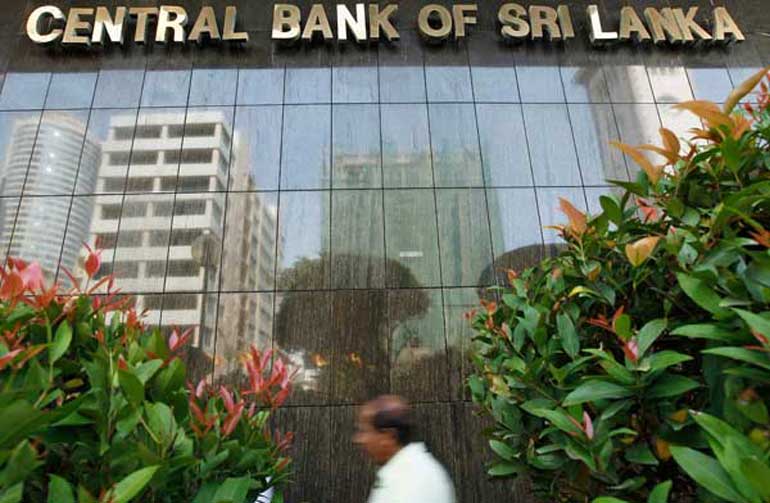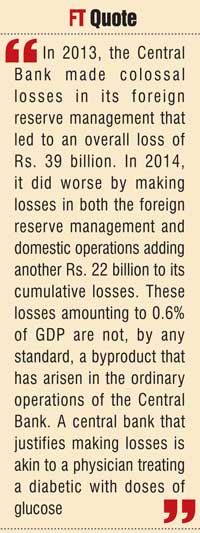Sunday Dec 07, 2025
Sunday Dec 07, 2025
Monday, 18 May 2015 00:00 - - {{hitsCtrl.values.hits}}

Treating losses lightly by the Central Bank
The Central Bank has issued a response (available here) to the article of this writer in this series titled ‘The continually loss-making Central Bank puts nation on red alert’ (available here).
The reading of the response reveals that while the arguments presented have been flimsy, the Central Bank has missed the main point as well. Such a casual approach to a critical issue by the Monetary Authority of the country, created by people to serve them as their trustee, puts the nation not on just red alert as suggested by the original article but on ‘extra’ red alert.
Five point argument by the Central Bank
Five arguments have been presented by the Central Bank in order to ‘correct a number of factual errors and possible misperceptions that could arise from the matters discussed in the Article’ by this writer. It is indeed the duty of the Central Bank to correct errors and remove misperceptions. But when doing so, the Bank should address the issue in question as a whole and not just cherry-pick some and ignore others that leads to bigger misperceptions.
A central bank can be forgiven for not making profits but not for making losses
Argument 1 of the Bank says that the Central Bank ‘being the authority for issuance of currency and monetary management is not considered a profit oriented institution in any economy’. Any profit or loss, according to the Bank, is just a byproduct of its operations. What it implies is that a central bank should not be taken to task if it has lower profitability or has made losses.
This is only partly true. That is because while a central bank can be forgiven for not making profits, it cannot be forgiven for making losses. This was clarified by this writer in a previous article in the Principles of Central Banking Series titled ‘Should central banks make profits’ (available at: http://www.ft.lk/article/192588/Should-central-banks-make-profits?).
The article under reference has argued that central banks can make profits just by buying securities and lending money through money creation and therefore, profit targets from its domestic operations are directly linked to inflation. Hence, central banks should not undermine their price stability objective by targeting for higher profits from their domestic operations.
Central banks are not supposed to make losses in foreign reserve management or losses continually
But, this is not applicable with respect to their foreign reserve management operations or when they make colossal losses continually. This is what this writer said in the article under reference: “Then, the question arises ‘shouldn’t a central bank make profits at all?’ The answer is no. They should definitely make profits in the case of foreign reserves they manage on behalf of the nation. There, the profits they earn come not from money creation but from conscious investment decisions they have made by taking into account the risk involved in each type of investments. In these operations, central banks should consciously target for the highest level of profits they could make but without putting the nation’s foreign reserves to unnecessary risks. As for domestic operations, profits are not targeted by a central bank but they arise in their ordinary monetary policy operations. In those operations, what a central bank should seek is to avoid making losses because if a central bank makes losses, those losses have to be financed by the country’s taxpayers. A central bank should avoid that possibility by all means.”
Continual losses in a central bank are akin to medicating a diabetic with continued doses of glucose
In 2013, the Central Bank made colossal losses in its foreign reserve management that led to an overall loss of Rs. 39 billion. In 2014, it did worse by making losses in both the foreign reserve management and domestic operations adding another Rs. 22 billion to its cumulative losses. These losses amounting to 0.6% of GDP are not, by any standard, a byproduct that has arisen in the ordinary operations of the Central Bank. A central bank that justifies making losses is akin to a physician treating a diabetic with doses of glucose.

Is maintaining a capital cover of 100% is unusual for a financial institution?
In its second argument, the Central Bank has downplayed the prudential decision taken by the Monetary Board in 2002 to increase the Bank’s capital cover to 100% of its domestic assets. The Bank says that “maintaining a 100% capital cover is unusual for any financial institution” and opines that that may have been “based on judgment of the Monetary Board at that time”.
Moving forward, the Central Bank claims that “subsequently, the Board had decided to revert to the original provision of the Monetary Law Act (MLA) of at least 15% of capital cover”. This is an instance where the Central Bank and its Monetary Board have shown their unfamiliarity of the role of capital funds in a Central Bank.
Building capital funds is an anti-inflationary measure
The importance of building internal reserves by the Central Bank was described by this writer in the article on ‘Should central banks make profits?’ as follows: “Why has it been prescribed that a central bank should first use its profits to build internal reserves? That is because today’s central banks issue currency without any backing of foreign exchange assets or gold and therefore there is no safety for the currency they issue. In the case of a currency board system which Sri Lanka had before it got its central bank in 1950, there should be a 100% backing of the currency it issues with foreign exchange balances. Hence, the entirety of the currency which a currency board has issued is backed by valuable foreign exchange. Countries like Singapore and Hong Kong still have currency boards to issue currencies in their respective regions. In the case of central banks, there is no legal requirement to back the currencies they issue by such foreign exchange balances and therefore, they could misuse their power to issue more currencies than necessary and thereby grow like an inverted pyramid. But the ultimate result of such a strategy is inflating the economy. To prevent central banks from getting into that trap, legal provisions have been made in the laws governing them to transfer their profits to such internal reserve accounts until such time they are considered adequate to protect the currencies they issue. Hence, it is an anti-inflationary measure introduced in central banking laws.”
Allowing capital cover to fall to the statutory minimum is an imprudent policy
The judgment of the Monetary Board in 2002 which the present Central Bank is downplaying as unusual for any financial institution was based on this wisdom. It was made by the Monetary Board in the interest of the people who have created the Central Bank and appointed the Monetary Board members as trustees and not as owners or masters.
If the subsequent Monetary Board, as claimed by the Central Bank, had gone back to the minimum requirement under the law which is 15%, when they made that decision, certainly they would not have the people whom they are to serve as trustees in their mind. Since their decision to reduce it to 15% means incurring losses continuously or transferring the accumulated capital funds of the Central Bank to political masters as profits or both, that subsequent wisdom has served only the political masters who are temporary holders of political power in the country.
During 2010-14, the Bank had made a total profit of only Rs 71 billion but it had transferred to the government as profit transfer much more than that amounting to Rs 115 billion. This is how the so called Monetary Board has reduced the capital cover as claimed by the Central Bank today.
A central bank has to continue as a strong institution and to continue as a strong institution, it should have enough capital to expand its domestic assets. Though the Central Bank says that it is unusual, it has required commercial banks to maintain capital even at 150% if the underlying asset, including those issued by governments, is rated below B-.
A central bank researcher on strong views on high capital funds in a central bank
Is there a knowledge deficiency within the Central Bank? That may not be the case because there are researchers on its staff who have done research on the importance of having a higher capital base – also known as networth – in a central bank. In the article referred to above, this writer reviewed such a research paper published by one of the researchers of the Bank – Anil Perera – together with two other academics.
This is what this writer said: “Three scholars, Anil Perera of the Central Bank of Sri Lanka and presently at Monash University, Australia, Deborah Ralston of Australian Centre for Financial Studies and Jayasinghe Wickramanayake of Monash University in a recent paper titled ‘Central bank financial strength and inflation: Is there a robust link?’ and published in the 2013 XXX issue of Journal of Financial Stability have examined this issue. For convenience of exposition, it is called hereafter PRW Study. Having used the data relating to selected advanced and emerging countries that include Sri Lanka as well, they have found a significant and robust negative relationship between central bank financial strength and inflation. What it means is that if the balance sheet of a central bank is strong enough with high internal reserves, that central bank is in a stronger position to conduct its monetary policy effectively and push inflation down.”
Higher the net worth, stronger the central bank
“PRW Study has recognised the limited availability of studies on the subject so far because it is still an unexplored area of study to establish the link between the central bank balance sheet and inflation. Having defined the strength of the balance sheet as the size of the net worth of a central bank – that is, the component of the assets of a central bank backed by its capital and internal reserves – the Study goes on to establish the link via the degree of independence enjoyed by a central bank. While profits are useful in improving the net worth of a central bank they are not essential since it could be improved by periodical allocation of funds by the government through annual budgets. A central bank with an improved financial net worth is in a position to implement aggressively inflation-fighting policies at the cost of incurring interest expenditure by issuing its own securities if the available government securities in its stock are insufficient to eliminate the entirety of the excess liquidity in the banking system. PRW Study argues that a weak central bank is unlikely to do so unless it is supported by a grant from the government.”
High net worth frees a central bank from government controls
This is where the size of the net worth and the independence of the central bank come to the picture. If the central bank is not independent from the government, it also cannot adopt a robust monetary policy without government’s blessings. When governments are bent on prioritising economic growth over inflation, it is unlikely that a central bank will get those blessings. Hence, both the independence and the size of the net worth helps a central bank to carry on its monetary policy stance unabated and undiminished.
Hence, the Monetary Board in its subsequent decision in which it had undermined the need for building a high net worth has driven the Bank to a vulnerable position by creating an environment where it would lose its independence. It cannot be categorised as an exercise of prudential diligence by the Monetary Board. It is also not a decision about which the nation can be pleased at all

Wrong speculation about the wisdom of the Board in 2002
The Central Bank response has speculated wrongly that the Board would have decided to build the Bank’s capital funds to avert the undesirable effects of the one-off capital inflows that came to the country after the Asian tsunami in 2004. The decision was taken by the Board in 2002, two years before the tsunami and it is inconceivable that the Board had prior knowledge of the oncoming tsunami.
Also the Central Bank’s claim that its buying of the foreign exchange inflow in 2005 to avoid the appreciation of the Rupee would have increased the capital funds at that time does not stand to any reason. The students of central banking know that buying foreign exchange by a central bank from the market simply increases the net foreign assets of the Bank and by an equivalent amount it increases the monetary base and not the capital funds.
Declining capital funds is the main issue and not the accuracy of the number
In its argument 3, the Bank has disputed the capital cover of 19% which this writer has mentioned and instead says that it should be 25%. This latter number is correct because this writer had failed to exclude foreign currency non-financial assets reported in the middle of the balance sheet from the domestic assets of the Bank. It is an oversight of this writer. Even then, it still indicates a decline from 103% in 2007 and 62% in 2013.
This is not the time to get involved in an argument whether the correct figure is 19% or 25%. It is like when the roof is burning, people inside instead of finding ways to get out quickly start an argument over who has set fire to the roof. The declining networth is a matter for grave concern and if the Central Bank feels that it should not be taken seriously, it is likely that a much worse disaster is gathering moment to hit the taxpayers of the country.
Current monetary policy based on standing deposit facility cannot be continued with a declining capital base
The arguments 4 and 5 are a justification of the use of the standing deposit system for monetary policy purposes. They jointly say that it has enabled the Bank to conduct its monetary policy effectively despite it resulting in an unprecedented out-payment of interest to commercial banks. As argued above, a central bank making continual losses will have to get a government grant to pay interest to commercial banks with excess funds.
Further, conducting monetary policy is costly because the nation has to maintain a luxurious central bank to do so. Yet, it should not be at the risk of having to recapitalise the central bank in massive amounts. At a time when the government is constrained by budgetary difficulties, such a recapitalisation could be made only by sacrificing expenditure elsewhere.
In all such cases in the rest of the world, governments have been quick on imposing conditions on central banks thereby taking away their budget independence – that is, their right to spend money without going through Parliamentary approval. When a central bank loses its budget independence, it loses its policy independence as well because politicians can always hold on to the approval of the budget until the Central Bank yields to their demands.
Central Bank’s future risks are enormous
The Central Bank in its response has assured the public that its risk management is being strengthened continuously. This is a good promise since the risk management practices reported in the Bank’s Annual Reports have covered from a past footprint-perspective and not from a forward-looking perspective.
A proper risk management will require the identification of the sources of future losses to the Bank. Three such critical areas will be interest out-payments, rising and uncontrolled administration expenses and, like the falling net worth, the erosion of the international reserve revaluation account or IRRA.
IRRA has fallen from Rs. 68 billion at end-2012 to Rs. 8.5 billion at end-2014. Any decline of the market value of foreign assets by just 1% will wipe out the entirety of IRRA eating into the paid-up capital of the Bank. It is therefore time for the Bank to get into a serious restructuring plan as it did in 2000 under the leadership of Governor A.S. Jayawardena.
The blind and imprudent erosion of the net worth
The subsequent Monetary Board which according to the Central Bank had taken a decision to reduce the Bank’s net worth to the bare minimum has blindly and imprudently left room for concerned governments to take away its independence. This is the main point the Central Bank has missed and when the Central Bank is managed by such a management, it certainly puts the nation on ‘extra’ red alert.
(W.A. Wijewardena, a former Deputy Governor of the Central Bank of Sri Lanka, can be reached at [email protected].)